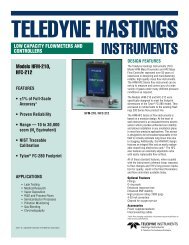HFM-401/405 - Teledyne Hastings Instruments
HFM-401/405 - Teledyne Hastings Instruments
HFM-401/405 - Teledyne Hastings Instruments
You also want an ePaper? Increase the reach of your titles
YUMPU automatically turns print PDFs into web optimized ePapers that Google loves.
Since the alarms act as switches they do not producea voltage or current signal. However, they can beused to generate a voltage signal on an Alarm Outline. This is done by connecting a suitable pull-upAlarm 1resistor between an external voltage supply and thedesired alarm line while connecting Alarm Commonto the common of the power supply. When activated,the alarm line voltage will be pulled toward the alarmcommon line generating a sudden drop in the signalAlarm 2line voltage.To use the alarm to illuminate an LED connect thepositive terminal of the LED to a suitable powersupply and connect the other end to a currentlimiting resistor. This resistor should be sized suchthat the current is less than 20 mA when the entiresupply voltage is applied. Connect the other end ofFigure 2-9 Alarm circuit diagramthe resistor to Alarm 1 or Alarm 2. Connect AlarmCommon to the circuit common of the power supply. When activated, the alarm line is pulled towardthe alarm common generating sufficient current through the LED to cause it to illuminate.Figure 2-10 shows an example of the LED circuit arrangement applied to Alarm 1 while Alarm 2 isconfigured with a suitable pull-up resistor to provide a voltage output on an Alarm Out line.Since the Alarm Common is ashared contact, if both alarmsare being used independentlythey must each be wired suchthat the current passesAlarm 1through the external signalingdevice before reaching theV +alarm line.The alarm settings andactivation status are availablevia software commands andqueries. The softwareinterprets an activated Alarm1 as an “Alarm” condition,while an activated Alarm2 isinterpreted as a “Warning”condition. The softwaremanual includes the detaileddescriptions for configuringand interpreting the activationof these alarms.Alarm 2Alarm CommonAlarm OutV -Alarm Common2.9. Auxiliary InputConnectionFigure 2-10 Alarm circuit diagram for LED operationThe <strong>Hastings</strong> 400 Series flow meters provide an auxiliary analog input function. The flow meter canread the analog value present between pins 5 and 6 on the terminal strip (as shown in Figure 2-2) andmake its value available via the digital interface. The accepted electrical input signal is the same as thatconfigured for the analog output signal (4 – 20 mA, 0 -20 mA, 0-5 Vdc, 1-5 Vdc, or 0-10 Vdc). Unlikethe analog output signal, which is isolated and capable operating at common mode offsets of over1000V, the analog input signal cannot be galvanically isolated from ground potential.<strong>401</strong>-<strong>405</strong> SERIES - 11 -
















